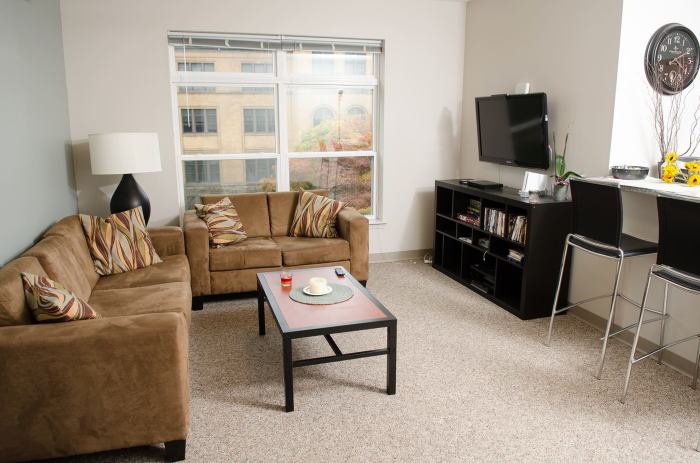
The decision to live off-campus during college is a significant one, often accompanied by the crucial question: can student loans cover the costs? This guide delves into the complexities of using student loan funds for off-campus housing, exploring budgeting strategies, housing options, and the potential impact on academic success. We’ll examine the realities of affordability, the various types of financial aid available, and the importance of responsible financial planning to navigate this important life decision.
Understanding the financial landscape of higher education is paramount for students aiming for off-campus living. This involves a careful assessment of available funds, realistic budgeting, and a thorough understanding of loan repayment terms. This guide aims to equip students with the knowledge and tools to make informed decisions regarding their housing choices and financial well-being.
Eligibility and Funding Sources

Securing funding for off-campus housing as a student often involves navigating various financial aid options and understanding their eligibility criteria. This section clarifies the different funding avenues available and the conditions attached to them, alongside examples illustrating scenarios where student loans might fall short.
Types of Student Financial Aid
Student financial aid encompasses a range of resources designed to assist students in meeting their educational expenses, including off-campus housing costs. These resources typically include grants, scholarships, and loans. Grants are generally need-based and do not require repayment. Scholarships are often merit-based, awarded based on academic achievement, extracurricular involvement, or other criteria. Loans, on the other hand, require repayment after graduation, with interest accruing over time. Federal student loans, such as subsidized and unsubsidized Stafford Loans, are commonly used, and private loans offer additional options.
Criteria for Receiving Student Loan Funds
Eligibility for student loans is determined by several factors, including the student’s enrollment status (full-time or part-time), financial need (as demonstrated through the Free Application for Federal Student Aid, or FAFSA), credit history (for private loans), and citizenship status. The amount a student can borrow is typically capped based on their year of study and overall dependency status. Students must maintain satisfactory academic progress to remain eligible for continued loan funding. For example, a student maintaining a minimum GPA or passing a certain number of credits per semester is often a requirement.
Situations Where Student Loans are Insufficient for Off-Campus Housing
While student loans can significantly contribute to off-campus housing costs, they may prove insufficient in several situations. High living costs in certain geographic locations, for instance, could easily exceed the maximum loan amount a student is eligible to receive. Unexpected expenses, such as emergency repairs or unforeseen medical bills, can also create a financial shortfall. Students choosing luxury housing options, exceeding their financial means, can also find themselves facing a significant funding gap. For example, a student receiving $10,000 in student loans annually might find it challenging to afford a $1,500 monthly rent in a high-cost city like New York City.
Affordability of On-Campus Versus Off-Campus Housing
The affordability of on-campus versus off-campus housing is highly dependent on the specific institution and its location. On-campus housing often provides a predictable cost, though it might be less flexible in terms of amenities and living arrangements. Off-campus housing offers greater flexibility but typically comes with higher costs and increased responsibility for utilities and maintenance. For instance, a dorm room might cost $8,000 annually, while a comparable off-campus apartment could easily cost $12,000 or more, depending on location and amenities.
Average Cost of Off-Campus Housing in Different Regions
| Region | Average Monthly Rent (1-Bedroom) | Average Monthly Rent (2-Bedroom) | Average Utilities (Monthly) |
|---|---|---|---|
| Northeast (US) | $1600 | $2200 | $200 |
| South (US) | $1200 | $1600 | $150 |
| Midwest (US) | $1000 | $1400 | $120 |
| West (US) | $1800 | $2500 | $250 |
Last Word

Successfully navigating the financial aspects of off-campus living requires careful planning, responsible borrowing, and a proactive approach to budgeting. By understanding the different types of financial aid, exploring various housing options, and developing sound financial strategies, students can make informed choices that support both their academic goals and their overall financial health. Remember, seeking guidance from financial aid offices and utilizing available resources can significantly enhance the decision-making process and minimize financial stress.
Clarifying Questions
Can I use my student loans for a security deposit?
While student loans can be used for living expenses, which may include a security deposit, it’s crucial to ensure your total loan amount aligns with your overall budget and doesn’t exceed your financial capacity. Consult your financial aid advisor for guidance.
Are there any restrictions on using student loans for off-campus housing?
Most student loan programs don’t explicitly prohibit using funds for off-campus housing, but it’s vital to ensure the expenses are reasonable and necessary. Excessive spending on housing might raise concerns during loan disbursement.
What if my student loans aren’t enough to cover off-campus housing?
Explore additional funding options like part-time jobs, scholarships, grants, or co-signing a lease with a roommate to reduce individual costs. Your university’s financial aid office can provide further assistance.
How do I avoid predatory lenders or scams related to off-campus housing?
Be wary of offers that seem too good to be true. Thoroughly research landlords and rental agencies, verify their legitimacy, and carefully review lease agreements before signing. Consult your university’s housing office or student services for resources and advice.
